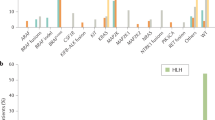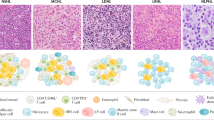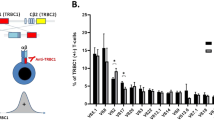Abstract
A panel of monoclonal antileucocyte antibodies was used in a study of Hodgkin's disease (HD) to explore the phenotypic characteristics of Sternberg-Reed and related cells (collectively termed HD cells). Cryostat preparations of 31 lymph nodes and 2 spleens were obtained from 30 patients with active HD. The histological diagnoses were: lymphocyte predominance (LP), 4 patients, nodular sclerosis (NS), 22; mixed cellularity (MC), 2; lymphocyte depletion (LD), 2. The monoclonal antibodies used were: OKT3, T11, Leu-1 (pan T cell specific); Leu-3A (T "helper" specific); Leu-2A, OKT8 (T "suppressor" specific); immunoglobulin (Ig) antibodies: anti kappa and lambda light chains, anti mu and delta heavy chains, B1 (anti B lymphocyte); CA2-11 (anti HLA-DR); OKM1, Mo-2 (anti myeloid/monocyte); OKT9 (anti transferrin receptor); Leu-7 (anti "NK" cell) and J5 (anti common ALL antigen). Reactions with peanut lectin (PNL) were also studied. The reactions were developed using a modified "ABC" immunoperoxidase technique. Specific attention was paid to the cell surface phenotype and anatomical localisation of HD cells in relation to surrounding T and B lymphocytes. HD cells formed distinct "rosettes" with T cells of "helper" phenotype although in 3 cases (1: LP, 2: NS) Leu-7 positive cells formed a prominent component of these interactions. In partially involved lymph node and spleen, HD cells were prominently distributed in a perifollicular distribution. In addition follicular mantle zones were frequently infiltrated by HD cells, the degree of ensuing destruction being related to the extent of lymph node effacement by HD. In 2 cases (1: NS, 1: LD) HD cells expressed clear, positive reactions with B1 although in neither of these cases nor in any other instance, was surface Ig expressed on the HD cell surface. The great majority of HD cells reacted positively with both OKT9 and, as previously reported, with anti HLA-DR antibody. In addition, HD cells demonstrated intense surface and cytoplasmic staining with PNL. HD cells were negative with all other antibodies. On the basis of these findings, no lineage specificity can confidently be attributed to the HD cell. However, the pattern of immunohistological reactions suggest that it is related to a cell of B follicular origins.
This is a preview of subscription content, access via your institution
Access options
Subscribe to this journal
Receive 24 print issues and online access
$259.00 per year
only $10.79 per issue
Buy this article
- Purchase on Springer Link
- Instant access to full article PDF
Prices may be subject to local taxes which are calculated during checkout
Similar content being viewed by others
Rights and permissions
About this article
Cite this article
Dorreen, M., Habeshaw, J., Stansfeld, A. et al. Characteristics of Sternberg-Reed, and related cells in Hodgkin's disease: An immunohistological study. Br J Cancer 49, 465–476 (1984). https://doi.org/10.1038/bjc.1984.74
Issue Date:
DOI: https://doi.org/10.1038/bjc.1984.74



